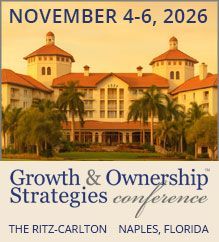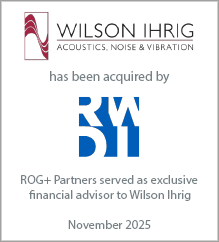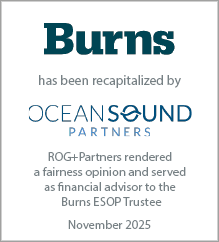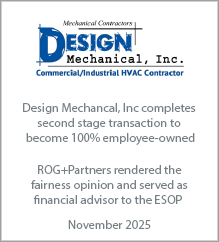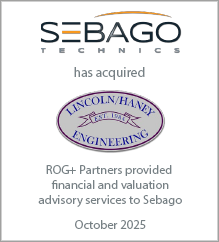Steve Gido specializes in corporate financial advisory services with a focus on mergers and acquisitions. Steve has assisted architecture, engineering, environmental consulting and construction firms of all sizes across North America achieve their growth or liquidity goals through successful mergers & acquisitions. Steve has over 15 years of investment banking experience and holds the chartered financial analyst (CFA) designation from the CFA Institute.
Growth 2.0 – The A/E Industry Reflects and Restarts
June 2020
It’s been approximately 100 days since the United States joined nations around the world in an unprecedented series of events to contain the coronavirus pandemic. Societal norms and business practices were overturned almost instantaneously, while slogans such as “flatten the curve,” “social distancing,” and “shelter in place” became part of the national conversation. The A/E community was no different, mobilizing workforces and operations at lightning speed and undertaking a “hunker down” mentality to focus on the health and safety of its staff and families. With no strategic plan or policy manual to consult, A/E leaders were simply guided by prudence, hustle, instinct, and teamwork - the results are nothing short of extraordinary.
Our ruminations and observations, incorporating dozens of ROG discussions with leaders and executives nationwide, include the following:
- The A/E industry was in remarkable shape coming into this – The recently released ENR 500 showed record total design revenue of $103 billion in 2019. U.S. domestic revenue growth was up an astounding 9% for the second year in a row (compare that to U.S. GDP of 2.3% last year). Many presidents and principals mentioned “record years” in 2019 and “strong backlogs” carrying them into the first quarter. Hiring remained rampant with record low unemployment for engineers, surveyors, architects, planners, tradespeople, and scientists. Industry and small business confidence surveys were at elevated levels. And yes, one could argue the country’s record 10-year expansion was due for a pullback with warning signs on trade, debt, and manufacturing. Still, this strong momentum was critical for organizational resiliency with what came next.
- Companies across the board have generally adapted well – Aided by years of consistent investment in IT platforms and digitalization practices, the shift to remote work environments was seamless and surprisingly effective from almost every leader we have spoken with. Project work and collaboration continued, marketing efforts and internal communications intensified, and “business as usual” mindsets took over as many office and field staff were deemed essential by state governments. In addition, A/E firms across the country announced succession plans, many hiring and summer internship programs stayed on course, and even M&A transactions continued to close, albeit with less frequency. Publicly traded engineering & construction stocks have soared since their March nadir.
- Growth in the upcoming quarters will be enormous – While the remaining trajectory and potency of a novel virus remains fluid, much of the country has opened up to various extents, and that will likely be irreversible. The federal government has basically underwritten this pandemic to the tune of trillions of dollars in emergency spending, and now the administration is eyeing a $1 trillion infrastructure proposal. The Federal Reserve has stated it will be accommodative for years with regards to monetary policy. Gas prices are low, and we see pent-up demand unfolding in travel and restaurant bookings, medical visits, and applications for cheap auto loans and home mortgages. Any positive developments on vaccines or treatments will likely be additive to overall consumer and business sentiment. A/E leaders we speak with are more than ready to safely interact with their colleagues again and miss the everyday office nuances from “hallway time” to collaborating around the conference room table.
- But that’s not to say all is rosy – Obviously, there are short and long-term headwinds to navigate for A/E firms everywhere. CFOs, steadfast on the front lines with navigating the complex and ever-changing PPP loan program, have expressed worries on A/R days lengthening, backlogs shrinking, and proposal volumes wavering. Several prominent firms, particularly in architecture, have had layoffs, and a sizable number of organizations have announced salary freezes or reductions. With many pools and summer camps closed and the model for K-12 schools this fall still in flux for many states, child care will be a significant bottleneck in offices returning to normal capacity. And while the working from home model has been lauded, we should note that between 22% and 35% of U.S. employees have experienced symptoms of depression, burn out, and isolation as they live through the pandemic and remote working, according to new research by the Society for Human Resource Management. Peering into 2021 raises a host of concerns on the durability of the recovery. What will capital spending budgets look like for a range of beleaguered industries and institutions, including oil & gas, healthcare, retail, office, aviation, religious, hospitality, and higher education? How will major shortfalls in federal, state, and local tax and toll revenues play into budgets for the next few years? Oh, and on top of all of that, we have a presidential election this fall, too.
- New Normal? Maybe…maybe not – Count us as fascinated with the breadth of profound predictions and critical assessments that have outlined how our lives could be forever reshaped due to this pandemic. As designers, planners, and scientists, it’s exciting to dream how buildings, communities, environments, and even societies could be enhanced for improved efficiency, functionality, and overall quality of life. History often shows that economic recessions and disruptions often accelerate trends that have already been set in motion. Today, these include forces such as: working from home (many A/E firms already leverage part-time and 1099 staff), online retail and delivery, millennial migration from the cities to the suburbs, population trends shifting to the south, and open office concepts (for better or for worse!), to name a few. In addition, there is the reality of the day-to-day inertia and habits of how people choose to live and work and the practicality of incremental costs in the big picture of A/E firms and their clients’ bottom lines. More than likely, we’ll see the adoption of some sensible measures and policies blended with a reflex “back to normal” trend line. Keep in mind the A/E industry is just three months removed from a business model that was producing record growth and profitability, so significant deviations from that could undoubtedly lead to uncharted waters.
***
This month marks ROG Partners’ 10th anniversary and we wanted to thank all of you who have supported us. Our mission today remains the same - to deliver unparalleled financial services to the A/E industry and provide reliable and objective advice based on a commitment to our client’s best interests. We are honored for the enduring relationships we have built and all the exceptional organizations we have assisted with measuring and enhancing their value.


